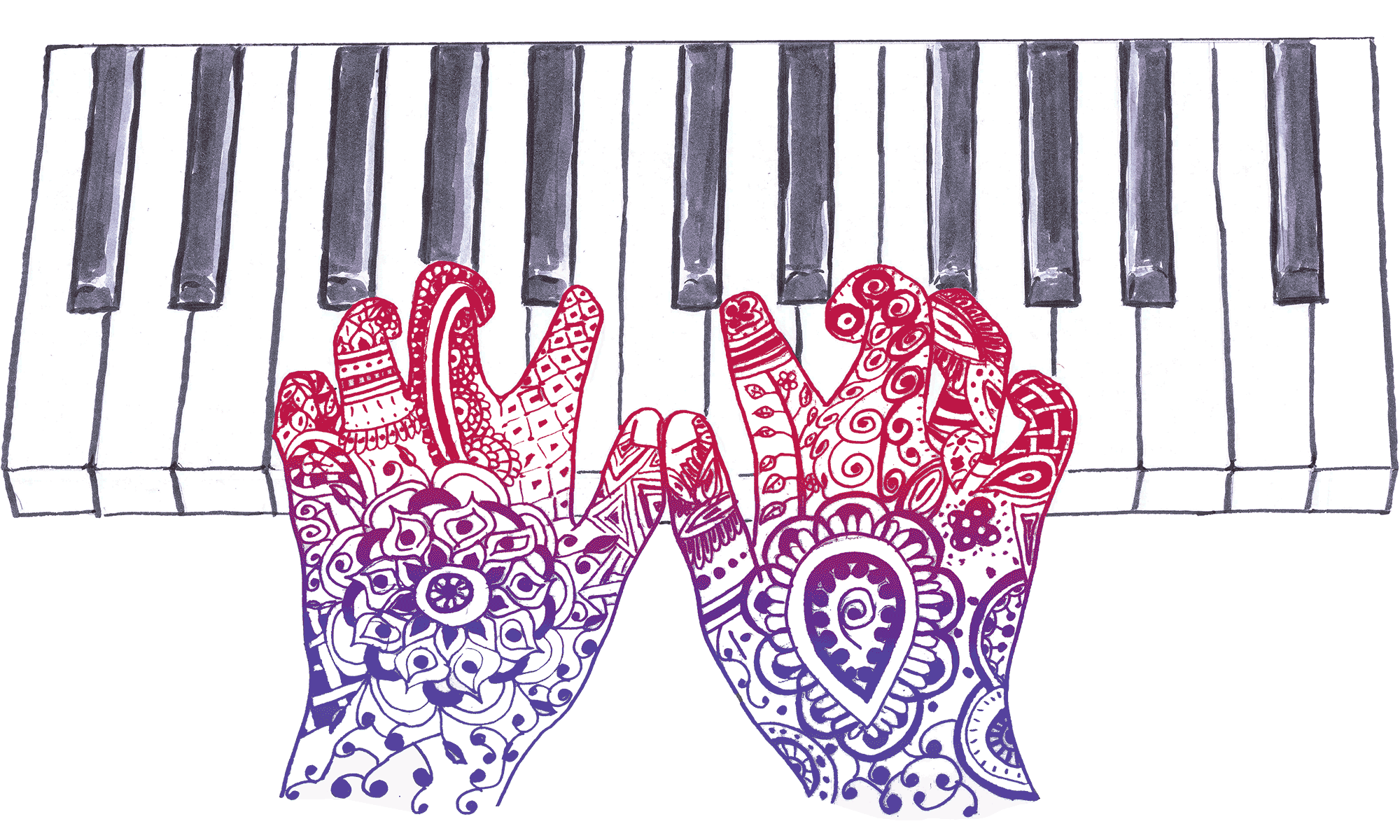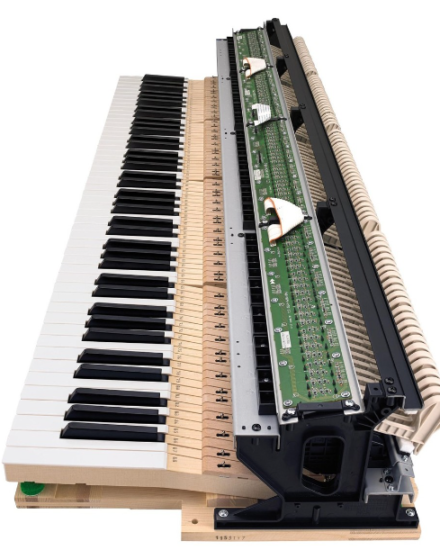More Choices Than Ever
Hybrid pianos represent an exciting new option for piano buyers. The technology is still fairly new, but hybrid pianos give the best of both worlds when it comes to pianos and keyboards. There are still few models to choose from and they are still relatively expensive but I believe they are poised to take over the market as musicians and teachers discover and work with them.
Pianos and keyboards will still exist because they fill specific needs but hybrid pianos fill a huge need that many people share. Many people want a piano but face space or noise issues. Families or musicians buying an instrument to practice on have traditionally had to make compromises. The sound and feel of an acoustic piano are quite appealing for many people, but there are practical issues to consider.
- Physical space requirement (even uprights)
- Heavy and expensive to move
- Upkeep – Needs regular tuning and maintenance
- Environmental sensitivity – Temperature and humidity changes affect pianos
- No realistic volume control
- Expensive
Digital pianos are a kind of keyboard designed to more closely replicate the feel of playing a piano while solving the volume and space issues that make a piano a difficult or unrealistic option in some circumstances.
Digital pianos have gotten increasingly better and manufacturers have done an amazing job recreating a piano’s sound with sophisticated sampling technology. The main area where they still struggle to match a piano is in the moving parts of the action and keys which create the feel of playing a piano’s keys. Beginners are less likely to be affected by this difference but as students become more advanced and nuanced in their playing it can start to matter. Still, the advantages to having a digital piano can be compelling.
- Not heavy – Anywhere from 30-75 lbs – easy to move around even with just one person
- Space-saving – Very slim profile, only a little bigger than the piano’s keys
- No Maintenance – Don’t need tuning or other maintenance
- Volume Control – Through speakers or headphones
- Connectivity – Access to music software for notation, recording or virtual instruments
- Affordability – Usually less expensive than piano
What Exactly Is A “Hybrid Piano”?
A small piano cabinet containing physical piano action with sensors on the hammers that trigger a sampled piano sound through speakers instead of hitting strings and being amplified by a soundboard. Hybrid pianos have taken the effort to get the speaker wattage and placement right creating a beautiful sounding experience for the player. The piano sampling is nuanced and beautiful allowing each section of the piano to showcase the ideal sound in that range and to replicate the different ways a player may strike a key changing in volume and tone.
Why Hybrid Pianos Are Amazing
You are actually playing an acoustic piano’s keys and action but now have:
- Volume Control-through speakers or headphones
- Slim Profile- saving space
- Very Little Maintenance – No tuning required or repairs to strings or soundboard. Regulation of action may be required occasionally (3-5 years).
- Very Little Sensitivity to Temperature and Humidity – No strings and soundboard mean that environment won’t affect tuning. (The action could be affected causing sticky keys.)
- USB MIDI Connectivity-to-computer
- USB Connectivity is a huge advantage if you want to do any recording. This gives the ability to edit with MIDI, allowing notes and rhythms to be changed, and then output to a high quality audio track from the keyboard’s line outs.
The only downsides of the Hybrid Piano are:
Still expensive relative to Digital Pianos (MSRP upwards of $4000, though street price will be lower)
Weight. About half the weight of a piano (from 170 – 240 lbs), but not easily moved on your own
Casio, Yamaha and Kawai currently make hybrid models. I got a chance to play them all in Japan recently and was so excited that we decided to get one for our studios at Treblemakers. They are not widely available in the U.S. yet but Cunningham Piano in King of Prussia, PA offers them with fantastic pricing.
Cunningham’s excellent reputation as a piano seller and rebuilder is well-deserved. I bought my piano there years ago and have sent quite a few families their way as I feel like they really listen and try to offer options that match students priorities and needs while still offering a good deal. Our recent visit to Cunningham proved them to be every bit as good as their reputation..
Casio’s Celviano GP-500 was the initial reason for our visit because of its balance between features and price. The sampled Bechstein sound when I played it in Japan had me in love, but after sitting and playing the Casio Celviano GP-500 and the Yamaha NU1, the full piano action of the Yamaha model won me over.
Over the years, I’ve had both Yamaha and Casio keyboards and have liked specific lines and models in each brand, but there are certainly positive and negative features in every product line.
Casio’s Celviano line has a partial action with some plastic parts and counterweights instead of the full action inside. It’s still a huge leap beyond the current digital piano lines and is a little less expensive than the Yamaha. But you do get what you pay for, and the full action of the Yamaha NU1 was simply elegant and a joy to play in comparison to any other Digital Piano I’ve ever played.
For our studios, the relatively small price difference was not worth the compromise on a major feature for such an expensive piece of equipment or instrument. The Yamaha also carries a few models that have a grand action inside (the NU1 has an upright action) but I felt like the price point on it made it less appealing. You could get an actual grand for the same money.
Casio Celviano GP-500
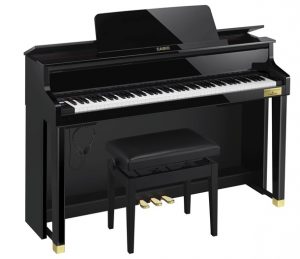
Casio Celviano GP-500 Action
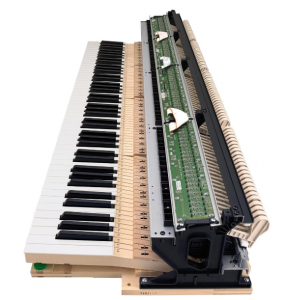
Yamaha NU1
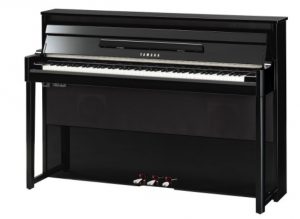
Yamaha NU1 Action
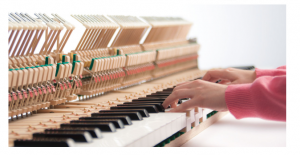
Kawai CA97B
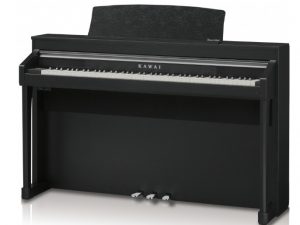
Kawai CA97B Action
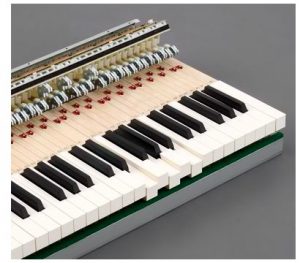
Definitions:
Sampling: The process of recording each note on an acoustic instrument to create a realistic sound. Many recordings are taken of each note to make it respond and sound like a real instrument would sound capturing the physical differences in how the note may be played.
Soundboard: A large wooden plate in a piano that amplifies the sound when the strings vibrate on it.
MIDI: Stands for Musical Instrument Digital Interface. This is the programming language that sends information (what notes are sounded, when, how hard etc.) from a digital instrument to the computer. When it plays back, it triggers an instrument inside the keyboard or a virtual instrument in the computer that replicates the performance using the information captured. Has more editing options and takes up less memory than recording audio sound waves of an instrument.
USB MIDI: Ability to transmit MIDI information using a USB cable.
Regulation of Action: Adjustment of the moving parts inside the action of a piano that allows the keys to be played evenly and smoothly. Can eliminate unwanted sounds such as rings or buzzes and reduces wear and tear from parts rubbing.
Virtual Instrument: An instrument sound generated within a computer that runs inside a computer program. It can be a sample (recording) of an instrument or synthesized (machine-created by algorithm). Often runs as a subprogram inside another piece of music software such as a music recording or notation program. It’s sound can be played (triggered) by a keyboard or other instrument connected to the computer through midi.
